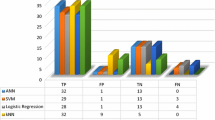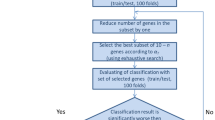Abstract
Gene expression microarrays allow for the high throughput analysis of huge numbers of gene transcripts and this technology has been widely applied to the molecular and biological classification of cancer patients and in predicting clinical outcome. A potential handicap of such data intensive molecular technologies is the translation to clinical application in routine practice. In using an artificial neural network bioinformatic approach, we have reduced a 70 gene signature to just 9 genes capable of accurately predicting distant metastases in the original dataset. Upon validation in a follow-up cohort, this signature was an independent predictor of metastases free and overall survival in the presence of the 70 gene signature and other factors. Interestingly, the ANN signature and CA9 expression also split the groups defined by the 70 gene signature into prognostically distinct groups. Subsequently, the presence of protein for the principal prognosticator gene was categorically assessed in breast cancer tissue of an experimental and independent validation patient cohort, using immunohistochemistry. Importantly our principal prognosticator, CA9, showed that it is capable of selecting an aggressive subgroup of patients who are known to have poor prognosis.

Similar content being viewed by others
Abbreviations
- ANN:
-
Artificial neural networks
- BCSS:
-
Breast cancer specific survival
- CA9:
-
Carbonic anhydrase IX
- EGF:
-
Epidermal growth factor
- DFI:
-
Disease-free interval
- EST:
-
Expressed sequence tag
- HR:
-
Hormonal receptors
- HIF-1α:
-
Hypoxia induced factor 1 alpha
- ROC:
-
Receiver operating characteristic
- RMH:
-
Royal marsden hospital
- TMA:
-
Tissue microarray
- TNP:
-
Triple negative phenotype
- AUC:
-
Area under the curve
References
Brown PO, Botstein D (1999) Exploring the new world of the genome with DNA microarrays. Nat Genet 21((1)(Suppl)):33–37. doi:10.1038/4462
Bhattacharjee A, Richards WG, Staunton J et al (2001) Classification of human lung carcinomas by mRNA expression profiling reveals distinct adenocarcinoma subclasses. Proc Natl Acad Sci USA 98(24):13790–13795. doi:10.1073/pnas.191502998
Khan J, Wei JS, Ringner M et al (2001) Classification and diagnostic prediction of cancers using gene expression profiling and artificial neural networks. Nat Med 7(6):673–679. doi:10.1038/89044
Rosenwald A, Wright G, Chan WC et al (2002) The use of molecular profiling to predict survival after chemotherapy for diffuse large-B-cell lymphoma. N Engl J Med 346(25):1937–1947. doi:10.1056/NEJMoa012914
Sorlie T, Perou CM, Tibshirani R et al (2001) Gene expression patterns of breast carcinomas distinguish tumor subclasses with clinical implications. Proc Natl Acad Sci USA 98(19):10869–10874. doi:10.1073/pnas.191367098
West M, Blanchette C, Dressman H et al (2001) Predicting the clinical status of human breast cancer by using gene expression profiles. Proc Natl Acad Sci USA 98(20):11462–11467. doi:10.1073/pnas.201162998
Callagy G, Cattaneo E, Daigo Y et al (2003) Molecular classification of breast carcinomas using tissue microarrays. Diagn Mol Pathol 12(1):27–34. doi:10.1097/00019606-200303000-00004
Paik S, Shak S, Tang G et al (2004) A multigene assay to predict recurrence of tamoxifen-treated, node-negative breast cancer. N Engl J Med 351(27):2817–2826. doi:10.1056/NEJMoa041588
Perou CM, Sorlie T, Eisen MB et al (2000) Molecular portraits of human breast tumours. Nature 406(6797):747–752. doi:10.1038/35021093
Abd El-Rehim DM, Ball G, Pinder SE et al (2005) High-throughput protein expression analysis using tissue microarray technology of a large well-characterised series identifies biologically distinct classes of breast cancer confirming recent cDNA expression analyses. Int J Cancer 116(3):340–350. doi:10.1002/ijc.21004
Masters JR, Lakhani SR (2000) How diagnosis with microarrays can help cancer patients. Nature 404(6781):921. doi:10.1038/35010139
Naderi A, Teschendorff AE, Barbosa-Morais NL et al (2007) A gene-expression signature to predict survival in breast cancer across independent data sets. Oncogene 26(10):1507–1516. doi:10.1038/sj.onc.1209920
van ‘t Veer LJ, Dai H, van de Vijver MJ et al (2002) Gene expression profiling predicts clinical outcome of breast cancer. Nature 415(6871):530–536. doi:10.1038/415530a
Fan C, Oh DS, Wessels L et al (2006) Concordance among gene-expression-based predictors for breast cancer. N Engl J Med 355(6):560–569. doi:10.1056/NEJMoa052933
Wirapati P, Sotiriou C, Kunkel S et al (2008) Meta-analysis of gene expression profiles in breast cancer: toward a unified understanding of breast cancer subtyping and prognosis signatures. Breast Cancer Res 10(4):R65. doi:10.1186/bcr2124
Lancashire LJ, Rees RC, Ball GR (2008) Identification of gene transcript signatures predictive for estrogen receptor and lymph node status using a stepwise forward selection artificial neural network modelling approach. Artif Intell Med 43(2):99–111. doi:10.1016/j.artmed.2008.03.001
Ball G, Mian S, Holding F et al (2002) An integrated approach utilizing artificial neural networks and SELDI mass spectrometry for the classification of human tumours and rapid identification of potential biomarkers. Bioinformatics 18(3):395–404. doi:10.1093/bioinformatics/18.3.395
Lancashire L, Schmid O, Shah H et al (2005) Classification of bacterial species from proteomic data using combinatorial approaches incorporating artificial neural networks, cluster analysis and principal components analysis. Bioinformatics 21(10):2191–2199. doi:10.1093/bioinformatics/bti368
Matharoo-Ball B, Ball G, Rees R (2007) Clinical proteomics: discovery of cancer biomarkers using mass spectrometry and bioinformatics approaches—a prostate cancer perspective. Vaccine 25(Suppl 2):B110–B121
van de Vijver MJ, He YD, van ‘t Veer LJ et al (2002) A gene-expression signature as a predictor of survival in breast cancer. N Engl J Med 347(25):1999–2009. doi:10.1056/NEJMoa021967
Rumelhart DE, Hinton GE, Williams RJ (1986) Learning representations by back-propagating errors. Nature 323:533–536
Picard RR, Cook RD (1984) Cross-validation of regression models. J Am Stat Assoc 79(387):575–583
Xu QS, Liang YZ, Du YP (2004) Monte Carlo cross-validation for selecting a model and estimating the prediction error in multivariate calibration. J Chemometr 18(2):112–120. doi:10.1002/cem.858
Shao J (1993) Linear model selection by cross-validation. J Am Stat Assoc 88(422):486–494. doi:10.2307/2290328
Efron B (1986) How biased is the apparent error rate of a prediction rule? J Am Stat Assoc 81(394):461–470. doi:10.2307/2289236
Bloom HJ, Richardson WW (1957) Histological grading and prognosis in breast cancer; a study of 1409 cases of which 359 have been followed for 15 years. Br J Cancer 11(3):359–377
Colpaert CG, Vermeulen PB, Fox SB et al (2004) The presence of a fibrotic focus in invasive breast carcinoma correlates with the expression of carbonic anhydrase IX and is a marker of hypoxia and poor prognosis. Breast Cancer Res Treat 81(2):137–147. doi:10.1023/A:1025702330207
Nielsen TO, Hsu FD, Jensen K et al (2004) Immunohistochemical and clinical characterization of the basal-like subtype of invasive breast carcinoma. Clin Cancer Res 10(16):5367–5374. doi:10.1158/1078-0432.CCR-04-0220
Raghunand N, He X, van Sluis R et al (1999) Enhancement of chemotherapy by manipulation of tumour pH. Br J Cancer 80(7):1005–1011. doi:10.1038/sj.bjc.6690455
van Berkel M, van der Groep P, Schvarts A et al (2002) HIF-1alpha/CAIX coexpression in invasive human breast cancer. Breast Cancer Res Treat 76(Suppl 1):S146
Saarnio J, Parkkila S, Parkkila AK et al (1998) Immunohistochemical study of colorectal tumors for expression of a novel transmembrane carbonic anhydrase, MN/CA IX, with potential value as a marker of cell proliferation. Am J Pathol 153(1):279–285
Liao SY, Brewer C, Zavada J et al (1994) Identification of the MN antigen as a diagnostic biomarker of cervical intraepithelial squamous and glandular neoplasia and cervical carcinomas. Am J Pathol 145(3):598–609
Hockel M, Schlenger K, Aral B et al (1996) Association between tumor hypoxia and malignant progression in advanced cancer of the uterine cervix. Cancer Res 56(19):4509–4515
Brizel DM, Scully SP, Harrelson JM et al (1996) Tumor oxygenation predicts for the likelihood of distant metastases in human soft tissue sarcoma. Cancer Res 56(5):941–943
Brennan DJ, Jirstrom K, Kronblad A et al (2006) CA IX is an independent prognostic marker in premenopausal breast cancer patients with one to three positive lymph nodes and a putative marker of radiation resistance. Clin Cancer Res 12(21):6421–6431. doi:10.1158/1078-0432.CCR-06-0480
Chia SK, Wykoff CC, Watson PH et al (2001) Prognostic significance of a novel hypoxia-regulated marker, carbonic anhydrase IX, in invasive breast carcinoma. J Clin Oncol 19(16):3660–3668
Tomes L, Emberley E, Niu Y et al (2003) Necrosis and hypoxia in invasive breast carcinoma. Breast Cancer Res Treat 81(1):61–69. doi:10.1023/A:1025476722493
Trastour C, Benizri E, Ettore F et al (2007) HIF-1alpha and CA IX staining in invasive breast carcinomas: prognosis and treatment outcome. Int J Cancer 120(7):1451–1458. doi:10.1002/ijc.22436
Kronblad A, Hedenfalk I, Nilsson E et al (2005) ERK1/2 inhibition increases antiestrogen treatment efficacy by interfering with hypoxia-induced downregulation of ERalpha: a combination therapy potentially targeting hypoxic and dormant tumor cells. Oncogene 24(45):6835–6841. doi:10.1038/sj.onc.1208830
Storci G, Sansone P, Trere D et al (2008) The basal-like breast carcinoma phenotype is regulated by SLUG gene expression. J Pathol 214(1):25–37. doi:10.1002/path.2254
Fadare O, Tavassoli FA (2007) The phenotypic spectrum of basal-like breast cancers: a critical appraisal. Adv Anat Pathol 14(5):358–373. doi:10.1097/PAP.0b013e31814b26fe
Van den Eynden GG, Smid M, Van Laere SJ et al (2008) Gene expression profiles associated with the presence of a fibrotic focus and the growth pattern in lymph node-negative breast cancer. Clin Cancer Res 14(10):2944–2952. doi:10.1158/1078-0432.CCR-07-4397
Cheang MC, Voduc D, Bajdik C et al (2008) Basal-like breast cancer defined by five biomarkers has superior prognostic value than triple-negative phenotype. Clin Cancer Res 14(5):1368–1376. doi:10.1158/1078-0432.CCR-07-1658
Turner NC, Reis-Filho JS (2006) Basal-like breast cancer and the BRCA1 phenotype. Oncogene 25(43):5846–5853. doi:10.1038/sj.onc.1209876
Vleugel MM, Greijer AE, Shvarts A et al (2005) Differential prognostic impact of hypoxia induced and diffuse HIF-1alpha expression in invasive breast cancer. J Clin Pathol 58(2):172–177. doi:10.1136/jcp.2004.019885
Gery S, Sawyers CL, Agus DB et al (2002) TMEFF2 is an androgen-regulated gene exhibiting antiproliferative effects in prostate cancer cells. Oncogene 21(31):4739–4746. doi:10.1038/sj.onc.1205142
Gery S, Koeffler HP (2003) Repression of the TMEFF2 promoter by c-Myc. J Mol Biol 328(5):977–983. doi:10.1016/S0022-2836(03)00404-2
Glinsky GV, Berezovska O, Glinskii AB (2005) Microarray analysis identifies a death-from-cancer signature predicting therapy failure in patients with multiple types of cancer. J Clin Invest 115(6):1503–1521. doi:10.1172/JCI23412
Hayama S, Daigo Y, Kato T et al (2006) Activation of CDCA1-KNTC2, members of centromere protein complex, involved in pulmonary carcinogenesis. Cancer Res 66(21):10339–10348. doi:10.1158/0008-5472.CAN-06-2137
Gurzov EN, Izquierdo M (2006) RNA interference against Hec1 inhibits tumor growth in vivo. Gene Ther 13(1):1–7. doi:10.1038/sj.gt.3302595
Acknowledgments
This study was supported by a grant from the UK HEFCE and ENACT (The European Network for the identification and validation of antigens and biomarkers in cancer and their application in clinical tumour immunology) and the Breast Cancer Campaign (2005). The authors thank Dr. Kay Savage for production of the Royal Marsden tumour tissue sections. Thanks also to the John and Lucille Van Geest Foundation.
Author information
Authors and Affiliations
Corresponding authors
Additional information
L. J. Lancashire and D. G. Powe contributed equally.
Electronic supplementary material
Below is the link to the electronic supplementary material.
Rights and permissions
About this article
Cite this article
Lancashire, L.J., Powe, D.G., Reis-Filho, J.S. et al. A validated gene expression profile for detecting clinical outcome in breast cancer using artificial neural networks. Breast Cancer Res Treat 120, 83–93 (2010). https://doi.org/10.1007/s10549-009-0378-1
Received:
Accepted:
Published:
Issue Date:
DOI: https://doi.org/10.1007/s10549-009-0378-1




